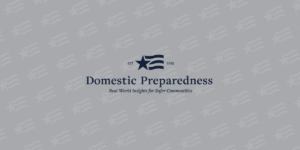
Setting & Maintaining Realistic Recovery Expectations
Stephen Grainer
August 26, 2015
There are many challenges as well as numerous nuances associated with disaster recovery operations that must be addressed by all levels of governmental, nongovernmental, and private sector agencies and organizations in order to ensure ongoing attention to all facets of the recovery effort, effectively building a resilient community.

Planning for Recovery: The Public Health Perspective
Marc Barbiere
August 19, 2015
Public health agencies at all levels have extensive experience recovering from disasters, mostly without the benefit of a pre-disaster recovery plan. Established guidance from a number of federal agencies coupled with an inclusive planning process can help public health agencies ensure that they and the critical services they provide are resilient after a disaster.

Screening Risk Analysis Tools for Resilience of Critical Infrastructure & Regions
Jerry P. Brashear, Paula Scalingi and Ryan Colker
August 19, 2015
Resilience, a central element in any recovery, is established before potentially disastrous events. Twenty-one federally sponsored risk methods and tools were screened for possible use as the core of a defensible, repeatable risk/resilience management process that would capture the greatest benefits for available budgets. None was fully ready for this role, but several hold promise for further improvement.

Modernizing the Nuclear Security Enterprise
Domestic Preparedness
August 16, 2015
The National Defense Authorization Act for Fiscal Year 2011 included a provision for the U.S. Government Accountability Office to study and report annually on whether the National Nuclear Security Administration’s

Correlation Between Land Use Decisions & Recovery Efforts
Charles (Chuck) Perino
August 12, 2015
This research develops a way of answering the question, “Should we continue to build there?” Past catastrophic disasters can help identify the economic, geopolitical, and social factors of each

Having the Right Tools to Shorten Periods of Chaos
Gordon Hunter
August 12, 2015
Disasters often lead to chaos, but how long the chaos lasts depends largely on the actions of the affected communities and whether all local resources are being used effectively.

Hurricane Sandy: An Investment Strategy Could Help the Federal Government Enhance National Resilience for Future Disasters
Domestic Preparedness
August 9, 2015
This report reviews the federal efforts to strengthen disaster resilience during Hurricane Sandy recovery and addresses: (a) how federal recovery funds were used to enhance resilience; (b) the extent to

Science Moving Forward: A Progress Report to the FDA Science Board
Domestic Preparedness
August 8, 2015
This report details how the U.S. Food and Drug Administration (FDA) has accelerated efforts to develop new approaches to engaging in synergistic collaborations both intramurally and with other government agencies,

New York City's Commodities Distribution & Recovery Planning
Paula M. Carlson and Thomas F. Healy
August 5, 2015
When planning and training for major disasters, communities often place more emphasis on the response rather than the recovery effort. However, it is critical that the recovery effort begins concurrent to the response in order for communities to be more resilient. New York City recognized this need and exercised one of its recovery plans.






